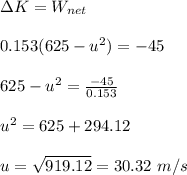
Physics, 18.03.2020 18:02 vickReis06
You throw a 3.00-N rock vertically into the air from ground level. You observe that when it is 15.0 m above the ground, it is traveling at 25.0 m/s upward. Use the work–energy theorem to find (a) the rock’s speed just as it left the ground and (b) its maximum height.

Answers: 2


Other questions on the subject: Physics

Physics, 22.06.2019 10:00, lorelei7668
(a) calculate the number of electrons in a small, electrically neutral silver pin that has a mass of 10.0 g. silver has 47 electrons per atom, and its molar mass is 107.87 g/mol. (b) imagine adding electrons to the pin until the negative charge has the very large value 1.00 mc. how many electrons are added for every 109 electrons already present
Answers: 3

Physics, 22.06.2019 16:20, devinfolds
Which best describes what forms in nuclear fission? a. two smaller, more stable nucleib. two larger, less stable nucleic. one smaller, less stable nucleusd. one larger, more stable nucleus
Answers: 1

Physics, 22.06.2019 21:30, amaraea
Which of these statements best explains how the hydrosphere interacts with the atmosphere to affect global climate? mountains block rain clouds and cause changes in global rainfall and evaporation. humans burn fossil fuels to produce greenhouse gases which cause global warming. humans cut down trees which affects the amount of oxygen in different parts of the globe. greenhouse gases, like carbon dioxide, dissolve in oceans and prevent global warming.
Answers: 1
You know the right answer?
You throw a 3.00-N rock vertically into the air from ground level. You observe that when it is 15.0...
Questions in other subjects:





Arts, 22.08.2019 23:20





 ) = 3.00 N
) = 3.00 N










